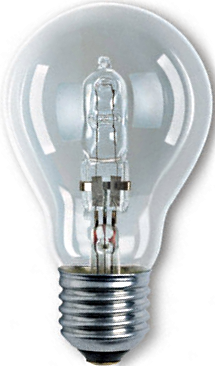Oh? I've recently found the halogen versions of regular bulbs for sale. Of course appliance bulbs are available, but they are low wattage.
Is the PTC similar for Halogen? And those also may not be around for long. 60W equivalent LEDs are around $1.50 making them very cost competitive.
The ones I see at the store are like this:
https://www.homedepot.com/p/Sylvani...-Light-Bulb-Soft-White-4-Pack-52603/204848825
It's a halogen lamp inside a normal P shaped bulb. Lower wattage for the same lumens as the old style.
https://www.homedepot.com/p/Sylvani...-Light-Bulb-Soft-White-4-Pack-52603/204848825
It's a halogen lamp inside a normal P shaped bulb. Lower wattage for the same lumens as the old style.
They have been around since California started the push for more lighting efficiency. The question is whether the off to on resistance change is as much as a traditional tungsten bulb. it would be worth measuring.
Is the PTC similar for Halogen? And those also may not be around for long. 60W equivalent LEDs are around $1.50 making them very cost competitive.
"Anything" Leds is USELESS. Sorry 🙁
We are not illuminating anything here, we NEED a high power, mains rated, current limiting PTC coefficient red hot piece of wire in series with mains supply.
Still available inside these:


There is a progressive ban going on so stock a few for Lab use.
They have been around since California started the push for more lighting efficiency. The question is whether the off to on resistance change is as much as a traditional tungsten bulb. it would be worth measuring.
It IS a traditional tungsten wire, only surrounded by a gas which makes it evaporate less.
Last edited:
Yes but it runs much hotter. It may be a bigger off to on ratio which would be good. Pretty simple to test. I'll get one next time I'm at a hardware store. I was not suggesting using an LED lamp as a current limiter. Just that the pervasive market penetration will effectively eliminate the incandescent lamp from the market. CFL's are vanishing as well. Stock up where ever you see incandescents.
Incandescent light bulbs will still be with us for a long time. There are still a few Edison units still around. They may eventually only show up at garage sales or the internet, but there are still applications where they work best.
The important issue is that when cold they can pass as much as ten times as much current as compared to when fully powered.
My basic light bulb box has three switches. So I can use a 25 watt lamp, a 60 watt lamp or a 500 watt one. It also allows for two or three to be in circuit at the same time. Yes I do test gear where a 500 watt lamp is useful!
My question is where did light bulb test bench current limiters start? I have been using one for 50 years now!
The important issue is that when cold they can pass as much as ten times as much current as compared to when fully powered.
My basic light bulb box has three switches. So I can use a 25 watt lamp, a 60 watt lamp or a 500 watt one. It also allows for two or three to be in circuit at the same time. Yes I do test gear where a 500 watt lamp is useful!
My question is where did light bulb test bench current limiters start? I have been using one for 50 years now!
Is this a good way to start building a Dim-Bulb tester??
https://www.instructables.com/Vintage-Dim-Bulb-Tester/
Or are these ok??
Dropbox - DimBulb Tester number 2.jpg - Simplify your life
https://www.instructables.com/Vintage-Dim-Bulb-Tester/
Or are these ok??
Dropbox - DimBulb Tester number 2.jpg - Simplify your life
Last edited:
Both seem good to me. Building a box around it is of course cooler, having it the barebones way works as long as you make it correct and safe (no open circuits, light-bulb not laying on the table...)
But those are USELESS for testing.Is the PTC similar for Halogen? And those also may not be around for long. 60W equivalent LEDs are around $1.50 making them very cost competitive.
it´s exactly the same, for same real power (not equivalent).They have been around since California started the push for more lighting efficiency. The question is whether the off to on resistance change is as much as a traditional tungsten bulb. it would be worth measuring.
- Home
- Design & Build
- Equipment & Tools
- Light bulb tester, just *how* does it work?